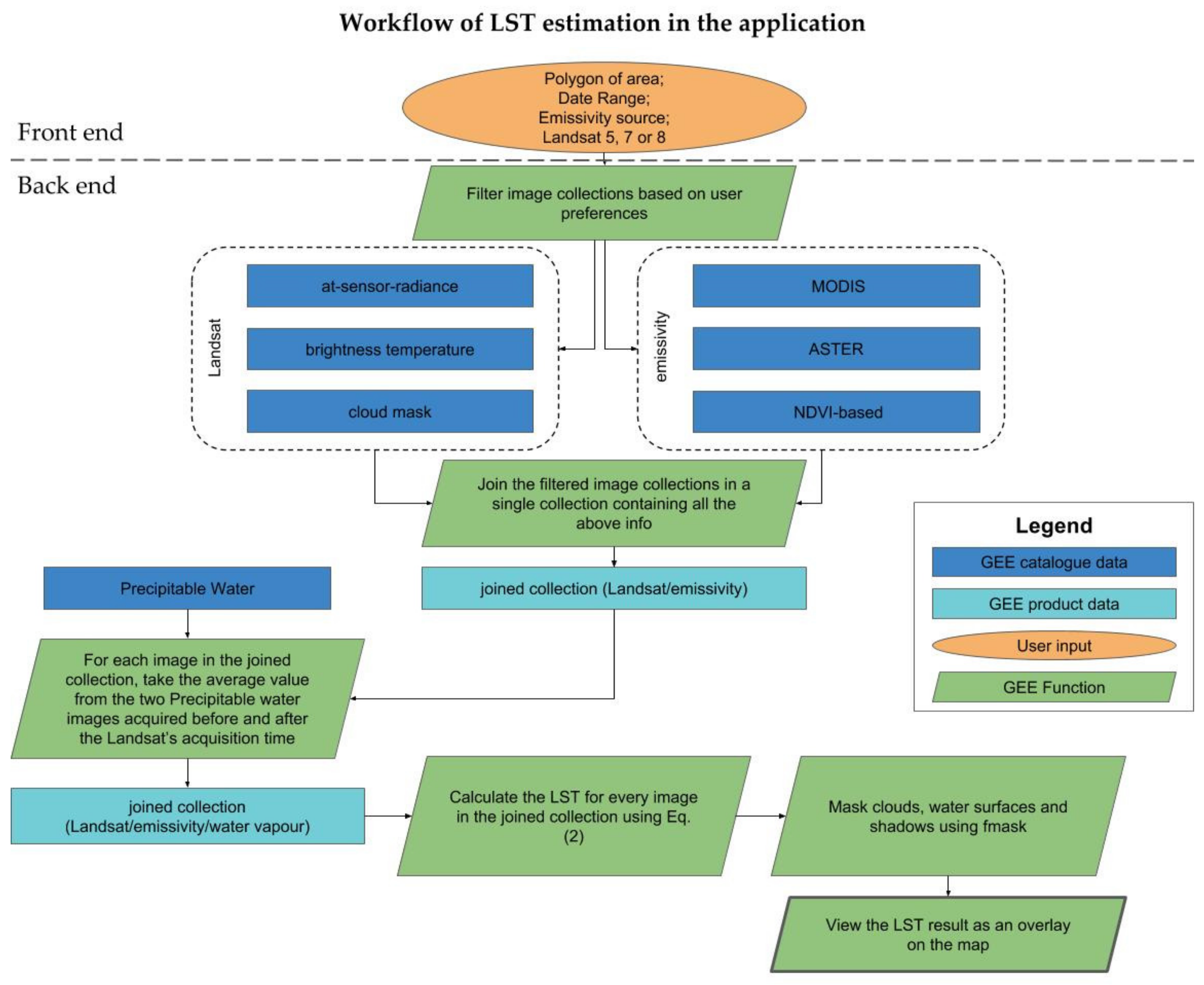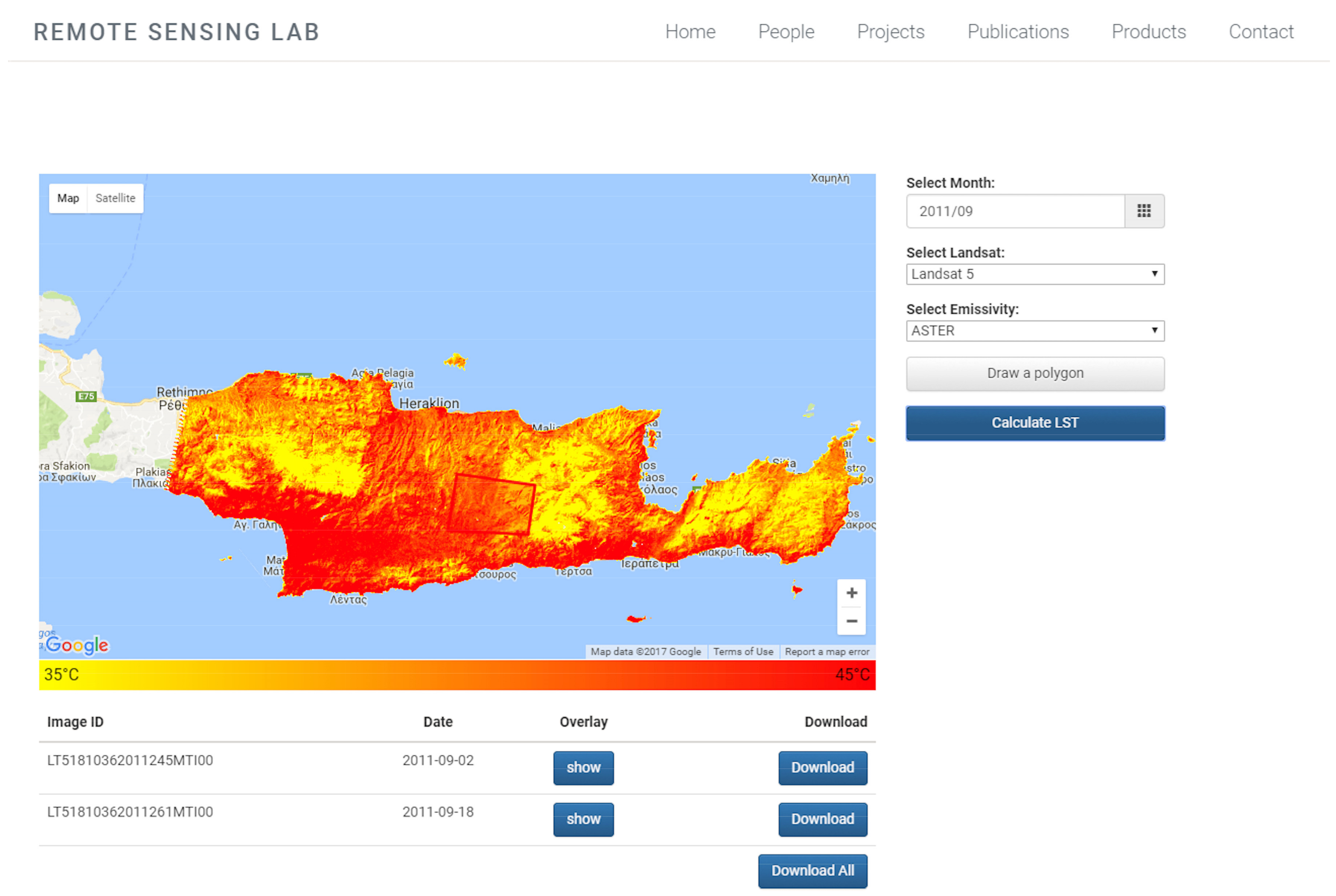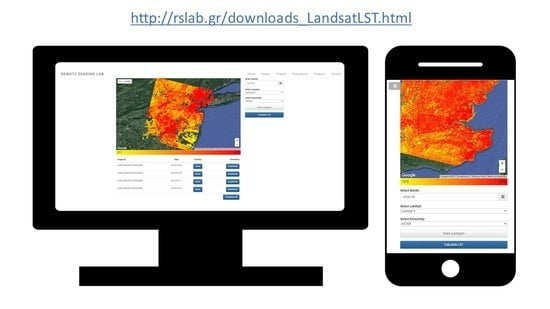Online Global Land Surface Temperature Estimation from Landsat
Abstract
:1. Introduction
2. Materials and Methods
2.1. LST Algorithm
2.2. Data Used for LST Estimation
2.2.1. Landsat Thermal Radiance-at-Sensor
2.2.2. Brightness Temperature and Cloud Mask
2.2.3. Landsat Surface Reflectance
2.2.4. Emissivity
2.2.5. Atmospheric PW Content
2.2.6. Coefficient Tables for Atmospheric Parameterization
2.3. LST Algorithm Implementation in the GEE
2.4. Accuracy Assesment
3. Results and Discussion
3.1. Accuracy Assesment
3.1.1. Atmospheric Effects: Coefficient Table Comparisons
3.1.2. Emissivity Effects: Comparisons of the Different Emissivity Retrieval Methods
3.1.3. Overall Accuracy Assessment of the Landsat LST Products
3.2. Landsat LST Web Application
4. Conclusions
Acknowledgments
Author Contributions
Conflicts of Interest
References
- Quattrochi, D.A.; Luvall, J.C. Thermal infrared remote sensing for analysis of landscape ecological processes: Methods and applications. Landsc. Ecol. 1999, 14, 577–598. [Google Scholar] [CrossRef]
- Chrysoulakis, N.; Lopes, M.; San José, R.; Grimmond, C.S.B.; Jones, M.B.; Magliulo, V.; Klostermann, J.E.M.; Synnefa, A.; Mitraka, Z.; Castro, E.A.; et al. Sustainable urban metabolism as a link between bio-physical sciences and urban planning: The BRIDGE project. Landsc. Urban Plan. 2013, 112, 100–117. [Google Scholar] [CrossRef]
- Chrysoulakis, N.; Marconcini, M.; Gastellu-Etchegorry, J.P.; Grimmond, C.S.B.; Feigenwinter, C.; Lindberg, F.; Del Frate, F.; Klostermann, J.; Mitraka, Z.; Esch, T.; et al. Anthropogenic Heat Flux Estimation from Space: Results of the second phase of the URBANFLUXES Project. In Proceeding of the Joint Urban Remote Sensing Event (JURSE 2017), Dubai, UAE, 30 March–1 April 2017. [Google Scholar]
- Kustas, W.; Anderson, M. Advances in thermal infrared remote sensing for land surface modeling. Agric. For. Meteorol. 2009, 149, 2071–2081. [Google Scholar] [CrossRef]
- Karnieli, A.; Agam, N.; Pinker, R.T.; Anderson, M.; Imhoff, M.L.; Gutman, G.G.; Panov, N.; Goldberg, A. Use of NDVI and land surface temperature for drought assessment: Merits and limitations. J. Clim. 2010, 23, 618–633. [Google Scholar] [CrossRef]
- Anderson, M.C.; Norman, J.M.; Kustas, W.P.; Houborg, R.; Starks, P.J.; Agam, N. A thermal-based remote sensing technique for routine mapping of land-surface carbon, water and energy fluxes from field to regional scales. Remote Sens. Environ. 2008, 112, 4227–4241. [Google Scholar] [CrossRef]
- Zhang, R.; Tian, J.; Su, H.; Sun, X.; Chen, S.; Xia, J. Two improvements of an operational two-layer model for terrestrial surface heat flux retrieval. Sensors 2008, 8, 6165–6187. [Google Scholar] [CrossRef] [PubMed]
- Hansen, J.; Ruedy, R.; Sato, M.; Lo, K. Global surface temperature change. Rev. Geophys. 2010, 48, RG4004. [Google Scholar] [CrossRef]
- Masiello, G.; Serio, C.; Venafra, S.; Liuzzi, G.; Göttsche, F.; Trigo, I.F.; Watts, P. Kalman filter physical retrieval of surface emissivity and temperature from SEVIRI infrared channels: A validation and intercomparison study. Atmos. Meas. Tech. 2015, 8, 2981–2997. [Google Scholar] [CrossRef]
- Ottlé, C.; Vidal-Madjar, D. Estimation of land surface temperature with NOAA9 data. Remote Sens. Environ. 1992, 40, 27–41. [Google Scholar] [CrossRef]
- Benas, N.; Chrysoulakis, N.; Cartalis, C. Trends of urban surface temperature and heat island characteristics in the Mediterranean. Theor. Appl. Climatol. 2016, 1–10. [Google Scholar] [CrossRef]
- Weng, Q.; Lu, D.; Schubring, J. Estimation of land surface temperature-vegetation abundance relationship for urban heat island studies. Remote Sens. Environ. 2004, 89, 467–483. [Google Scholar] [CrossRef]
- Tomlinson, C.J.; Chapman, L.; Thornes, J.E.; Baker, C. Remote sensing land surface temperature for meteorology and climatology: A review. Meteorol. Appl. 2011, 18, 296–306. [Google Scholar] [CrossRef]
- Rogan, J.; Ziemer, M.; Martin, D.; Ratick, S.; Cuba, N.; DeLauer, V. The impact of tree cover loss on land surface temperature: A case study of central Massachusetts using Landsat Thematic Mapper thermal data. Appl. Geogr. 2013, 45, 49–57. [Google Scholar] [CrossRef]
- Van Leeuwen, T.T.; Frank, A.J.; Jin, Y.; Smyth, P.; Goulden, M.L.; van der Werf, G.R.; Randerson, J.T. Optimal use of land surface temperature data to detect changes in tropical forest cover. J. Geophys. Res. 2011, 116, 1–16. [Google Scholar] [CrossRef]
- Ayanlade, A. Remote sensing approaches for land use and land surface temperature assessment: A review of methods. Int. J. Image Data Fusion 2017, 8, 188–201. [Google Scholar] [CrossRef]
- Wan, Z. A generalized split-window algorithm for retrieving land-surface temperature from space. IEEE Trans. Geosci. Remote Sens. 1996, 34, 892–905. [Google Scholar] [CrossRef]
- Coll, C.; Caselles, V. A split-window algorithm for land surface temperature from advanced very high resolution radiometer data: Validation and algorithm comparison. J. Geophys. Res. 1997, 102, 16697–16713. [Google Scholar] [CrossRef]
- Jimenez-Munoz, J.C.; Cristobal, J.; Sobrino, J.A.; Sòria, G.; Ninyerola, M.; Pons, X. Revision of the single-channel algorithm for land surface temperature retrieval from Landsat thermal-infrared data. IEEE Trans. Geosci. Remote Sens. 2009, 47, 339–349. [Google Scholar] [CrossRef]
- Jimenez-Munoz, J.C.; Sobrino, J.A.; Skokovic, D.; Mattar, C.; Cristobal, J. Land surface temperature retrieval methods from Landsat-8 thermal infrared sensor data. IEEE Geosci. Remote Sens. Lett. 2014, 11, 1840–1843. [Google Scholar] [CrossRef]
- Quantum Geographic Information System (QGIS). Available online: http://www.qgis.org/en/site/index.html (accessed on 30 August 2017).
- Ndossi, M.I.; Avdan, U. Application of open source coding technologies in the production of Land Surface Temperature (LST) maps from Landsat: A PyQGIS plugin. Remote Sens. 2016, 8, 413. [Google Scholar] [CrossRef]
- ERDAS Field Guide Manual. Available online: http://gisknowledge.net/topic/imagine_training/imagine_field_guide_05.pdf (accessed on 19 September 2017).
- Avdan, U.; Jovanovska, G. Algorithm for automated mapping of land surface temperature using Landsat 8 satellite data. J. Sens. 2016, 2016, 1–8. [Google Scholar] [CrossRef]
- Landsat Higher Level Science Data Products. Available online: https://landsat.usgs.gov/landsat-higher-level-science-data-products (accessed on 6 September 2017).
- Yu, X.; Guo, X.; Wu, Z. Land surface temperature retrieval from Landsat 8 TIRS-comparison between radiative transfer equation-based method, split window algorithm and single channel method. Remote Sens. 2014, 6, 9829–9852. [Google Scholar] [CrossRef]
- NASA EOSDIS Land Processes DAAC (LPDAAC). ASTER Global Emissivity Dataset, 100-Meter, HDF5. 2014. Available online: https://data.nasa.gov/Earth-Science/ASTER-Global-Emissivity-Database-100-meter-HDF5-V0/mijt-xkx7 (accessed on 20 November 2017).
- Hulley, G.C.; Hook, S.J.; Abbott, E.; Malakar, N.; Islam, T.; Abrams, M. The ASTER Global Emissivity Dataset (ASTER GED): Mapping Earth’s emissivity at 100 meter spatial scale. Geophys. Res. Lett. 2015, 42, 7966–7976. [Google Scholar] [CrossRef]
- Wan, Z.; Hook, S.; Hulley, G. MOD11A1 MODIS/Terra Land Surface Temperature/Emissivity Daily L3 Global 1 km SIN Grid V006. 2015. Available online: https://lpdaac.usgs.gov/dataset_discovery/modis/modis_products_table/mod11a1_v006 (accessed on 20 November 2017).
- Carlson, T.N.; Ripley, D.A. On the relation between NDVI, fractional vegetation cover, and leaf area index. Remote Sens. Environ. 1997, 62, 241–252. [Google Scholar] [CrossRef]
- Gorelick, N.; Hancher, M.; Dixon, M.; Ilyushchenko, S.; Thau, D.; Moore, R. Google Earth Engine: Planetary-scale geospatial analysis for everyone. Remote Sens. Environ. 2017. [Google Scholar] [CrossRef]
- Sobrino, J.A.; Jiménez-Muñoz, J.C.; Paolini, L. Land surface temperature retrieval from Landsat TM 5. Remote Sens. Environ. 2004, 90, 434–440. [Google Scholar] [CrossRef]
- Dash, P.; Göttsche, F.-M.; Olesen, F.-S.; Fischer, H. Land surface temperature and emissivity estimation from passive sensor data: Theory and practice-current trends. Int. J. Remote Sens. 2002, 23, 2563–2594. [Google Scholar] [CrossRef]
- What Are Band Designations Landsat Satellites. Available online: https://landsat.usgs.gov/what-are-band-designations-landsat-satellites (accessed on 1 September 2017).
- Landsat 8 OLI and TIRS. Available online: https://lta.cr.usgs.gov/L8 (accessed on 4 September 2017).
- 2010_Landsat_Updates. Available online: https://landsat.usgs.gov/sites/default/files/documents/2010_Landsat_Updates.pdf (accessed on 4 September 2017).
- Gao, B.-C.; Kaufman, Y.J. Water vapor retrievals using Moderate Resolution Imaging Spectroradiometer (MODIS) near-infrared channels. J. Geophys. Res. Atmos. 2003, 108. [Google Scholar] [CrossRef]
- Zhu, Z.; Woodcock, C.E. Object-based cloud and cloud shadow detection in Landsat imagery. Remote Sens. Environ. 2012, 118, 83–94. [Google Scholar] [CrossRef]
- Zhu, Z.; Wang, S.; Woodcock, C.E. Improvement and expansion of the Fmask algorithm: Cloud, cloud shadow, and snow detection for Landsats 4–7, 8, and Sentinel 2 images. Remote Sens. Environ. 2015, 159, 269–277. [Google Scholar] [CrossRef]
- Masek, J.G.; Vermote, E.F.; Saleous, N.; Wolfe, R.; Hall, F.G.; Huemmrich, F.; Gao, F.; Kutler, J.; Lim, T.K. LEDAPS Landsat Calibration, Reflectance, Atmospheric Correction Preprocessing Code. 2012. Available online: https://daac.ornl.gov/MODELS/guides/LEDAPS.html (accessed on 20 November 2017).
- Mitraka, Z.; Chrysoulakis, N.; Kamarianakis, Y.; Partsinevelos, P.; Tsouchlaraki, A. Improving the estimation of urban surface emissivity based on sub-pixel classification of high resolution satellite imagery. Remote Sens. Environ. 2012, 117, 125–134. [Google Scholar] [CrossRef]
- Chen, F.; Yang, S.; Su, Z.; Wang, K. Effect of emissivity uncertainty on surface temperature retrieval over urban areas: Investigations based on spectral libraries. ISPRS J. Photogramm. Remote Sens. 2016, 114, 53–65. [Google Scholar] [CrossRef]
- Snyder, W.C.; Wan, Z. BRDF models to predict spectral reflectance and emissivity in the thermal infrared. IEEE Trans. Geosci. Remote Sens. 1998, 36, 214–225. [Google Scholar] [CrossRef]
- Wan, Z. MODIS Land-Surface Temperature Algorithm Theoretical Basis Document (LST ATBD), Version 3.3. Available online: https://modis.gsfc.nasa.gov/data/atbd/atbd_mod11.pdf (accessed on 6 September 2017).
- Kalnay, E.; Kanamitsu, M.; Kistler, R.; Collins, W.; Deaven, D.; Gandin, L.; Iredell, M.; Saha, S.; White, G.; Woollen, J.; et al. The NCEP/NCAR 40-year reanalysis project. Bull. Am. Meteorol. Soc. 1996, 77, 437–471. [Google Scholar] [CrossRef]
- Chrysoulakis, N.; Kamarianakis, Y.; Xu, L.; Mitraka, Z.; Ding, J. Combined use of MODIS, AVHRR and radiosonde data for the estimation of spatiotemporal distribution of precipitable water. J. Geophys. Res. Atmos. 2008, 113. [Google Scholar] [CrossRef]
- Dee, D.P.; Uppala, S.M.; Simmons, A.J.; Berrisford, P.; Poli, P.; Kobayashi, S.; Andrae, U.; Balmaseda, M. A.; Balsamo, G.; Bauer, P.; et al. The ERA-Interim reanalysis: Configuration and performance of the data assimilation system. Q. J. R. Meteorol. Soc. 2011, 137, 553–597. [Google Scholar] [CrossRef]
- Gillespie, A.; Rokugawa, S.; Matsunaga, T.; Cothern, J.S.; Hook, S.; Kahle, A.B. A temperature and emissivity separation algorithm for Advanced Spaceborne Thermal Emission and Reflection Radiometer (ASTER) images. IEEE Trans. Geosci. Remote Sens. 1998, 36, 1113–1126. [Google Scholar] [CrossRef]
- Hulley, G.C.; Hughes, C.G.; Hook, S.J. Quantifying uncertainties in land surface temperature and emissivity retrievals from ASTER and MODIS thermal infrared data. J. Geophys. Res. 2012, 117. [Google Scholar] [CrossRef]
- Hook, S.J.; Vaughan, R.G.; Tonooka, H.; Schladow, S.G. Absolute Radiometric in-Flight Validation of Mid Infrared and Thermal Infrared Data from ASTER and MODIS on the Terra Spacecraft Using the Lake Tahoe, CA/NV, USA, Automated Validation Site. IEEE Trans. Geosci. Remote Sens. 2007, 45, 1798–1807. [Google Scholar] [CrossRef]
- Richter, R.; Schläpfer, D. Atmospheric/Topographic Correction for Satellite Imagery (ATCOR-2/3 User Guide ATCOR-2/3 User Guide Version 9.0.2, March 2016). Available online: http://www.rese.ch/pdf/atcor3_manual.pdf (accessed on 21 November 2017).
- Blasi, M.G.; Liuzzi, G.; Masiello, G.; Serio, C.; Telesca, V.; Venafra, S. Surface parameters from SEVIRI observations through a kalman filter approach: Application and evaluation of the scheme to the southern Italy. Tethys 2016, 2016, 1–19. [Google Scholar] [CrossRef]
- Sobrino, J.A.; Jiménez-Muñoz, J.C.; Sòria, G.; Romaguera, M.; Guanter, L.; Moreno, J.; Plaza, A.; Martínez, P. Land surface emissivity retrieval from different VNIR and TIR sensors. IEEE Trans. Geosci. Remote Sens. 2008, 46, 316–327. [Google Scholar] [CrossRef]





| Thermal Band(s) # | Wavelength (μm) | Spatial Resolution (m) | Time Period | |
|---|---|---|---|---|
| Landsat 5 | Band 6 | 10.40–12.50 | 120 (30) 1 | March 1984–May 2012 |
| Landsat 7 | Band 6 | 10.40–12.50 | 60 (30) 1 | April 1999–Present |
| Landsat 8 | Band 10 Band 11 | 10.60–11.19 11.50–12.51 | 100 (30) 1 | April 2013–Present |
| Data | GEE Product Identifier |
|---|---|
| Landsat 5, Radiance at sensor from band 6 | LANDSAT/LT5_L1T |
| Landsat 5, Brightness temperature from band 6 | LANDSAT/LT5_L1T_TOA_FMASK |
| Landsat 7, Radiance at sensor from band 6 | LANDSAT/LE7_L1T |
| Landsat 7, Brightness temperature from band 6 | LANDSAT/LE7_L1T_TOA_FMASK |
| Landsat 8, Radiance at sensor from band 10 | LANDSAT/LC8_L1T |
| Landsat 8, Brightness temperature from band 10 | LANDSAT/LC8_L1T_TOA_FMASK |
| MODIS Daily average emissivity from bands 31 and 32 | MODIS/MOD11A1 |
| NCEP/NCAR 6-hour temporal resolution of the total column water vapour from a single band | NCEP_RE/surface_wv |
| ASTER 1 Global image with emissivity from 2000–2008 clear-sky pixels from band 14 | NASA/ASTER_GED/AG100_003 |
| Landsat 5, Surface Reflectance product | LANDSAT/LT5_SR |
| Landsat 7, Surface Reflectance product | LEDAPS/LE7_L1T_SR |
| Landsat 8, Surface Reflectance Product | LANDSAT/LC8_SR |
| Fmask, from extra band in GEE’s Brightness temperature products | LANDSAT/LT5_L1T_TOA_FMASK LANDSAT/LE7_L1T_TOA_FMASK LANDSAT/LC8_L1T_TOA_FMASK |
| Emissivity Source | Band(s) # | Wavelength (μm) | Temporal Resolution | Spatial Resolution (m) |
|---|---|---|---|---|
| ASTER | 10 11 12 13 14 | 8.125–8.825 8.475–8.825 8.925–9.275 10.25–10.95 10.95–11.65 | 1 static image with average pixel values from 2000–2008 | 90 |
| MODIS | 31 32 | 10.78–11.28 11.77–12.27 | Daily, 2000–present | 1000 |
| NDVI based Landsat 5 | 3 1 4 1 | 0.63–0.69 0.76–0.90 | About every 16 days, 1984–2012 | 30 |
| NDVI based Landsat 7 | 3 1 4 1 | 0.63–0.69 0.77–0.90 | About every 16 days, 1999–present | 30 |
| NDVI based Landsat 8 | 4 1 5 1 | 0.636–0.673 0.851–0.879 | About every 16 days, 2013–2017 | 30 |
| Area of the Scene | Satellite | Acquisition Date | Spatial Resolution (m) | Location (Latitude, Longitude) | Area Size (km2) | PW (g/cm2) |
|---|---|---|---|---|---|---|
| The West Virginia mountains | ASTER | 11 October 2004 | 90 | 38.6621, −80.4140 | 2.449 | 0.72 |
| Amazon forest | ASTER | 7 September 2010 | 90 | −0.2032, −57.4076 | 2.321 | 4.32 |
| Bangkok | ASTER | 11 December 2014 | 90 | 13.8167, 100.4589 | 2.660 | 2.42 |
| Sahara Desert | ASTER | 27 October 2016 | 90 | 26.2330, 26.2820 | 2.346 | 2.20 |
| Dubai | ASTER | 29 June 2009 | 90 | 25.2831, 55.3724 | 1.560 | 0.83 |
| Tokyo | ASTER | 10 May 2015 | 90 | 35.6729, 139.7488 | 2.522 | 1.10 |
| Basel | Landsat 5 | 31 July 2010 | 30 | 47.5608, 7.5846 | 415 | 1.54 |
| Basel | Landsat 8 | 24 April 2015 | 30 | 47.5608, 7.5846 | 415 | 0.97 |
| Basel | Landsat 8 | 23 August 2016 | 30 | 47.5608, 7.5846 | 415 | 2.92 |
| Heraklion | Landsat 5 | 19 February 2010 | 30 | 35.3398, 25.1330 | 191 | 1.06 |
| Heraklion | Landsat 5 | 16 July 2011 | 30 | 35.3398, 25.1330 | 191 | 2.02 |
| Heraklion | Landsat 8 | 29 July 2016 | 30 | 35.3398, 25.1330 | 191 | 2.60 |
| Heraklion | Landsat 8 | 7 March 2016 | 30 | 35.3398, 25.1330 | 191 | 1.36 |
© 2017 by the authors. Licensee MDPI, Basel, Switzerland. This article is an open access article distributed under the terms and conditions of the Creative Commons Attribution (CC BY) license (http://creativecommons.org/licenses/by/4.0/).
Share and Cite
Parastatidis, D.; Mitraka, Z.; Chrysoulakis, N.; Abrams, M. Online Global Land Surface Temperature Estimation from Landsat. Remote Sens. 2017, 9, 1208. https://doi.org/10.3390/rs9121208
Parastatidis D, Mitraka Z, Chrysoulakis N, Abrams M. Online Global Land Surface Temperature Estimation from Landsat. Remote Sensing. 2017; 9(12):1208. https://doi.org/10.3390/rs9121208
Chicago/Turabian StyleParastatidis, David, Zina Mitraka, Nektrarios Chrysoulakis, and Michael Abrams. 2017. "Online Global Land Surface Temperature Estimation from Landsat" Remote Sensing 9, no. 12: 1208. https://doi.org/10.3390/rs9121208






